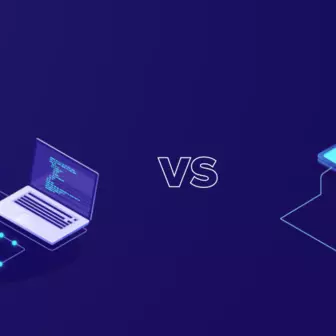Over the past few years, the cloud industry has gone through an extreme change with the transformation of serverless computing. The tech giants have already begun exploring this newly evolved cloud technology at its best.
You will find a race among various cloud service providers in offering serverless computing to its potential users.
So, let’s today talk about one of the leading competitors, AWS for its effective and reliable serverless cloud infrastructure.
Serverless on AWS: What do you mean by it?
We will begin by understanding what exactly is AWS Serverless Architecture and why do you need it?
AWS Serverless Computing Architecture can be considered as a means for building and running services and applications without the need to manage infrastructures. Even though users’ applications run on servers, still servers are managed by AWS.
Based on the computation, the users are charged for the services they use. So, basically it's a process that offers support for back-end services.
Now, let’s get an idea of why you should opt for serverless on AWS despite the different options you have?
Go with serverless on AWS for its plethora of benefits
So, to start with, after the introduction of Lambda in 2014, AWS came up with a wide variety of fully-managed serverless services for its users. Take a look at the various serverless services offered by AWS to its potential users.

Serverless Computation Services
AWS Serverless offers AWS Lambda which allows the user to run code without even managing servers, and in fact, the user pays only for the computation used. Lambda Edge enables users to run Lambda functions at AWS Edge locations in response to events of Amazon CloudFront AWS Fargate.
Serverless Storage Services
Amazon S3 offers a developing team with secure, durable, and highly-scalable object storage. It’s also very simple to use and portable Amazon EFS provides scalable, pure, elastic file storage. And it’s self-adjusting and shrinks and grows as per the user's demand.
Serverless Data Store Services
AWS provides Amazon DynamoDB which is a flexible and fast No-SQL database service for all applications; it requires millisecond latency at any scale.
Amazon Aurora Serverless - This is an on-demand (MySQL-compatible system) auto-scaling configuration. So, in this, the database starts and shuts down automatically. The system will scale in accordance with the user's application's needs.
API Proxy Services
Amazon API Gateway – This is a fully managed service that makes the developer’s task easy to build, maintain, monitor, publish, and secure APIs at any scale.
Gateways enable you to process thousands of concurrent API calls and help the user in handling traffic management, authorization and access control, monitoring, and API version management.
Application Integration Services
Amazon SNS – This is a fully managed pub/sub messaging service that helps decouple and scale microservices, distributed systems, and serverless applications.
Amazon SQS – This is a fully managed messaging service that helps decouple and scale microservices, distributed systems, and serverless applications.
AWS AppSync – This helps simplify application development by allowing you to build a flexible GraphQL API, it helps in securing access, manipulating, and combining data from one or more data sources.
Amazon EventBridge - This is an event bus service for serverless computing that helps in making easy access to application data from various sources and also sends it into the user's AWS environment.
Orchestration Services
Orchestration is critical to a serverless platform’s success. As companies can be seen adopting serverless architectures, there is an emerging need to orchestrate complex workflows with decoupled components.
Therefore, AWS Step Functions can be considered as a visual workflow service that satisfies this requirement. It is basically used to orchestrate AWS services, automate business processes, and build serverless applications.
Also, Step Functions helps in managing failures, retries, parallelization, service integrations, and observability so developers can concentrate on higher-value business logic.
Analytics Services
Amazon Kinesis – This is used to stream data on AWS. Kinesis provides great services that help in loading and analyzing the streaming data.
Amazon Athena – This is a service that is interactive and makes it simple and easy to analyze the data in Amazon S3 using standard SQL. Also, Athena is serverless.
Developer Tooling Services
AWS offers tools and services that help developers in the serverless application development process. It provides many more tools such as tools for continuous integration, testing, delivery, deployments, monitoring and diagnostics, frameworks, SDKs, and integrated development environment (IDE) plugins.
Serverless Automated Deployment
With an automated deployment pipeline from the AWS Lambda console, users can smoothly make a serverless application. AWS services integrated with AWS SAM are generally utilized to automate deployments.
AWS SAM helps in deploying new versions of the Lambda function and also creates aliases automatically to the latest version.
Also, if gradual rollouts are enabled with the help of AWS SAM, a CodeDeploy resource is created automatically for the user.
Serverless Authentication with JSON Web Tokens
Authentication helps in determining if the client's credentials are valid or not. And authorization helps in identifying what functions a client can perform. Even though the clients can be different for different clients.
JSON Web Tokens (JWT)
It is a compact and self-contained way that helps in transmitting information securely. This can be considered as a string that comprises three components separated by character.
Learn more:
End note
I hope this article helped you in getting a proper idea about why you need to choose AWS Serverless Architecture.
So, by adopting AWS Serverless Computing you can seamlessly run your business and let your developers get the benefits of advanced scalability, flexibility, quick time to release, and basically all this at a very reduced cost as your user pays for the services only used.
Subscribe
Related Blogs
Serverless vs Managed Services: Which One to Choose

When you decide to build an application in the cloud, you need to consider several factors. One of the most important…
Putting The Serverless Trend Under a Microscope

Flexible. Scalable. Economical. These terms essentially sum up the advantages of serverless computing, an architecture that…
Adopting Cloud-native in DevOps: A Journey

Traditional measures of development and delivery of software are taking new shapes in terms of faster, easier and powerful…




